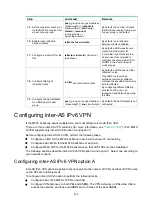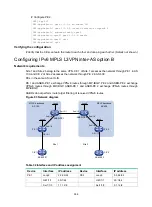
348
Configuring an IPv6 MPLS L3VPN over a GRE tunnel
Network requirements
CE 1 and CE 2 belong to VPN 1. The PEs support MPLS, while the P router does not support MPLS
and provides only IP features.
On the backbone, use a GRE tunnel to encapsulate and forward packets for IPv6 MPLS L3VPN.
Configure tunnel policies on the PEs, and specify the tunnel type for VPN traffic as GRE.
Figure 91 Network diagram
Table 30 Interface and IP address assignment
Device
Interface
IP address
Device
Interface
IP address
CE 1
GE1/1/1
2001:1::1/96
P POS1/1/0
172.1.1.2/24
PE 1
Loop0
1.1.1.9/32
POS1/1/1 172.2.1.1/24
GE1/1/1
2001:1::2/96
PE 2
Loop0
2.2.2.9/32
POS1/1/1
172.1.1.1/24
GE1/1/1
2001:2::2/96
Tunnel0
20.1.1.1/24
POS1/1/0 172.2.1.2/24
CE 2
GE1/1/1
2001:2::1/96
Tunnel0
20.1.1.2/24
Configuration procedure
1.
Configure an IGP on the MPLS backbone to ensure IP connectivity among the PEs and the P
router.
This example uses OSPF. (Details not shown.)
# Execute the
display ospf peer
command to verify that OSPF adjacencies in Full state have
been established between PE 1, P, and PE 2. Execute the
display ip routing-table
command
to verify that the PEs have learned the routes to the loopback interfaces of each other. (Details
not shown.)
2.
Configure basic MPLS on the PEs:
# Configure PE 1.
<PE1> system-view
Loop0
Loop0
POS1/1/0
POS1/1/1
POS1/1/0
POS1/1/1
Tunnel0
Tunnel0
GE1/1/1
GE1/1/1
GE1/1/1
GE1/1/1
CE 1
CE 2
VPN 1
VPN 1
AS 65410
AS 65420
PE 1
PE 2
P
AS 100
GRE tunnel
















































